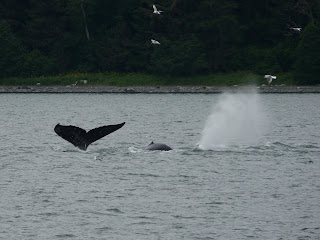Last week I had the privilege of witnessing a group of Humpback Whales bubblenet feeding just outside of Juneau in the Lynn Canal.
"It was one of the most amazing things I have ever seen in my life."
I've been saying that a lot since I came to Alaska!
"It was one of the most amazing things I have ever seen in my life."
I've been saying that a lot since I came to Alaska!
At one time Humpback Whales were almost hunted to extinction, until the International Whaling Commission put a ban on commercial Humpback whaling in 1966. Now the estimated population is somewhere around 80,000 worldwide.
It didn't take long to spot this group of 10 rounding up some herring for their next meal. From a distance you'll spot a spray of mist shooting out of the water. That would be them, exhaling from lungs that can be as big as a Volkswagen Beetle. As they cruise along, their dorsal fin rolls above the water's surface. Then, as they dive deeper, the fluke comes up, over, and gracefully back into the water.
I had these 3 demonstrate


Humpbacks can dive as deep as 700 feet for up to 30 minutes.
Each whale has a distinctive pattern on the bottom of it's Fluke. Biologists use these markings to identify them and track their progress over the years. The Humpbacks we see here in Alaska migrate over 15,000 miles each year. They spend the summers taking advantage of the abundance of food in Alaskan waters, then give birth in much warmer seas near Hawaii or Southern California during the winter. The mother's milk is over 50% fat and the calves can consume over 100 gallons per day. During the winter they do not eat, so all of that milk is still produced with no food intake. Imagine how hungry the mother is by the time she makes it back to Alaska. Humpbacks feed 22 hours of the day, often taking in over 2,000 lbs of food.
 As you can see, they come quite close to the boat at times.
As you can see, they come quite close to the boat at times.



 Bubblenet Feeding
Bubblenet Feeding
First, they swim in a shrinking circle below the school of fish, blowing bubbles as they go. The circle of bubbles creates a curtain and pushes the fish into a tighter ring. Once the signal is given, often vocally, they all swim up through the school of fish with their mouths wide open. Their mouths can fills with 15,000 gallons of water and fish, then they push out all of the water and swallow the good stuff. Its amazing to see how they all work together.
I'd say they probably get a bird or two every now and then.






 Wow!
Wow!


 Don't worry. Even though you could fit everyone on the back of that boat, and some in the whale's mouth, their throat is only about 10 inches wide. You'd probably get whipped around a little though, by the 2,000 lb tongue before you escape through the plates of baleen that are used to keep the good stuff in as they expel the water.
Don't worry. Even though you could fit everyone on the back of that boat, and some in the whale's mouth, their throat is only about 10 inches wide. You'd probably get whipped around a little though, by the 2,000 lb tongue before you escape through the plates of baleen that are used to keep the good stuff in as they expel the water.
 I was like a kid at Christmas out there. They just kept doing it again and again, every 10 minutes or so. The gulls alert you every time because they follow the whales and dive toward them just before they erupt out of the water.
I was like a kid at Christmas out there. They just kept doing it again and again, every 10 minutes or so. The gulls alert you every time because they follow the whales and dive toward them just before they erupt out of the water.






 Wow!
Wow!


 Don't worry. Even though you could fit everyone on the back of that boat, and some in the whale's mouth, their throat is only about 10 inches wide. You'd probably get whipped around a little though, by the 2,000 lb tongue before you escape through the plates of baleen that are used to keep the good stuff in as they expel the water.
Don't worry. Even though you could fit everyone on the back of that boat, and some in the whale's mouth, their throat is only about 10 inches wide. You'd probably get whipped around a little though, by the 2,000 lb tongue before you escape through the plates of baleen that are used to keep the good stuff in as they expel the water.
 I was like a kid at Christmas out there. They just kept doing it again and again, every 10 minutes or so. The gulls alert you every time because they follow the whales and dive toward them just before they erupt out of the water.
I was like a kid at Christmas out there. They just kept doing it again and again, every 10 minutes or so. The gulls alert you every time because they follow the whales and dive toward them just before they erupt out of the water.



Hey my name is steven. i am from fort mill, sc. i believe you mom works at my bank and she asked me about school. i told her i was majoring in history. I was wondering if you had any advice on how i should start my career. if you could i would appriciate any helpful advice.
ReplyDeletesimpsost@email.uscb.edu